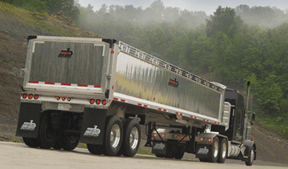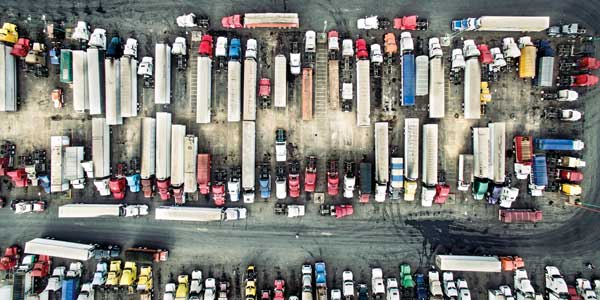 The process of choosing the best specifications for trailers used in bulk hauling applications can be complicated.
The process of choosing the best specifications for trailers used in bulk hauling applications can be complicated.
Understanding the heavy loads these vehicles will carry, unique dumping requirement and the harsh environments can mean the difference between how well units perform and how easy they are to maintain.
Among the most important choices when spec’ing trailers for bulk hauling applications the suspension. Investing time and effort in evaluating what’s available and what meets a fleet’s particular needs will ensure reliable, trouble-free operation over a long service life. A hasty choice may result in diminishes performance and costly maintenance and downtime.
Finding the best answers to key questions about suspensions for bulk trailers can have a positive and significant impact on a fleet’s bottom line. Many of these questions can be answered by discussing them with the industry’s suppliers, who can help make an educated decision based on a carrier’s needs. These companies offer a range of products and options to choose from.
Options
ArvinMeritor provides the Meritor RFS Series Suspension System for trailers used in bulk operations such as flatbeds, tankers and others. The single-axle RFS Series air suspension uses interleaf shims for fore and aft stiffness. The axle has a narrow design to cut weight and smaller diameter air springs that allow clearance in tight spaces. The system, according to the manufacturer, also employs shock absorbers with increased damping force for less fatigue damage and improved braking performance and tire life.
Hendrickson offers a range of suspensions for bulk applications, including tankers, dumps, grain haulers and other specialty trailers. Included are the QUAANTUM FX and the INTRAAX Top Mount Series, Low-Ride Height/Liftable and AANL Low-Ride Height tapered Bream models. In addition, the INTRAAX Extreme-Duty suspension is offered in both top-mount and low-ride designs for off-road and heavy hauling applications and the INTRAAX AANT is available as a lightweight air-ride suspension system for liquid and bulk tankers, bottom dumps and other trailer models.
The Holland Group also provides a variety of suspensions for bulk trailers. Included for on/off-highway applications are the CB2300 air-ride suspension/axle system, and the Top Mount Fixed Frame Air-Ride RL-230, RL-250 Heavy Duty and RL-300 Extreme Duty models. RLU-228 Under Mount Fixed Frame Air-Ride and a heavy-duty version RLU-250 are offered as well. In addition, for heavy-duty use the manufacturer has its TS Series single point, the TR Series tri and quad axle, the WB Series and the SB Series spring beam heavy vocational mechanical suspensions in its product line.
Unique requirements
One type of bulk vehicle with its own set of unique specification requirements are dump trailers. Manufacturers offer the trailers in aluminum and steel frame. Also, frame designs can be frameless or quarter frame. The proper selection and specification of dump trailers to meet an application’s particular needs is essential to ensuring productivity and efficiency.
Any decisions should begin with a clear understanding of all of the possible applications for the dump trailer a fleet is buying and specifying it to account for all of those considerations.
“Making sure you know how versatile or specific your dump trailer specs need to be is of utmost importance,” said Lenny Miller, vice president of sales and marketing at Benson International. “Especially if you’re hauling a mix of products it’s imperative to know what your trailers will be carrying.”
Dump trailers are generally classified in three ways– frameless, frame type and quarter frame—with each featuring characteristics that make it appropriate for different applications. Frameless dump trailers use the trailer’s rear axle for support. When dumping, the axle serves as a hinge point and the trailer and tractor create a scissor like action where one moves toward the other.
Frame type trailers are best suited to operations where dumping occurs on less stable ground. In these applications, the trailer and tractor remain stationary during dumping and the rear hinge and lifting cylinder provide support. Quarter frame trailers, which feature a frame from the front of the axle assembly to the midpoint of the dump body, are used when a fixed dump height is needed for feeding materials into equipment such as paving machines.
Each of the three dump trailer designs offers a different level of stability, a factor that Bill Garrison, vice president of sales and marketing at Clement Industries, says is one of the first considerations to take into account.
“Frame designs are the most stable and quarter frame models are next, followed by frameless,” Garrison said. “Also important is maneuverability, with the shortest unit possible to do the job and carry the payload preferred.”
A fourth and somewhat unique dump trailer design are the side dump trailers offered by Sidump’r Trailer Co. These vehicles feature a center-mounted cylinder that extends to tip the dump body, which sits on three cradles.
“Sidump’r trailers are designed with a crossmember with cutouts between the frame rails,” says Gary Schoepf, national sales manager of Sidump’r Trailers . “This enables the weight to shift on the pivot points and handle stresses when dumping.”
Another aspect of spec’ing dump trailers is whether they will be operated under federal or state length and weight regulations. Dump trailer specifications can vary by region because some states require compliance with the Federal Bridge Formula, relates Rod Fuge, inside sales at Trail King. “That will have an influence on how axles are set and spaced, and complying with some state Bridge Formula weight limits may mean axle and gross weights are higher or lower than the federal limits.”
Choices
Dump trailers choices also include steel and aluminum models with the most effective decision based on the materials being hauled. For example, while aluminum can provide a weight saving advantage in terms of higher payload capacity, steel dumps are often preferred for heavy materials. In addition, some types of commodities can damage aluminum more easily.
Where a trailer is dumping materials and how it will be piled are considerations when spec’ing dump trailers as well. Smaller frame type trailers, for example, may be advantageous because they can be maneuvered easily while longer frameless units have more capacity for stockpiling materials. Similarly, where there are confined areas, such as in cities, quarter frame trailers may be most desirable.
A trend in dump trailer specifications is the growing use of air ride suspensions, which some manufacturers report are being specified in as many as 90 percent of all units. The benefits include an improved ride and less shock loading, which lead to longer equipment life. In addition, by releasing air when dumping, air ride suspensions improve safety by lowering the vehicle’s center of gravity.
For Charlie Wells, director of dump trailer products and dealer development at East Manufacturing, tractor specifications are important to consider when buying dump trailers. Among the items to review, he points out, are wheelbase, weight, axle loads and 5th wheel settings. “It’s all about having a clear picture of what an operation needs,” Wells says. “Manufacturers and fleets should account for all the factors so they can find the best design for the application.”
Lowboy option
According to Rogers Trailers, its Ultima Series lowboy trailers are now available in production models of 35-, 50-, 55- and 60-ton capacity models. The company notes that the cambered main-beams, fabricated with 100k psi and 130k-psi materials, reduce the trailer’s tare weight while maintaining the strength and durability that are the hallmark of Rogers trailers.

In addition, the trailer maker offers popular accessories available on the Ultima models, which are wheel wells, self-adjusting front folding ramps, full center decking and removable swinging side brackets. Specialized models offer a wider selection of payload capacities, deck styles, gooseneck lengths, and other options and accessories to simplify any hauling need. The number of hauling configurations can be maximized with a minimum investment by taking advantage of Ultima’s detachable rear frame, interchangeable decks and detachable axles.
Rogers No Foot self-lifting gooseneck quickly and easily raises or lowers the front of the deck under full load without a ram foot contacting the ground, is standard equipment, the company says. Boom wells and notched deck crossmembers allow equipment to ride low, consequently reducing load height. Self-aligning tapered beam hooks assure a positive gooseneck-to-deck connection and make reconnecting a one-man, one-minute operation. For more information, visit www.rogerstrailers.com.


